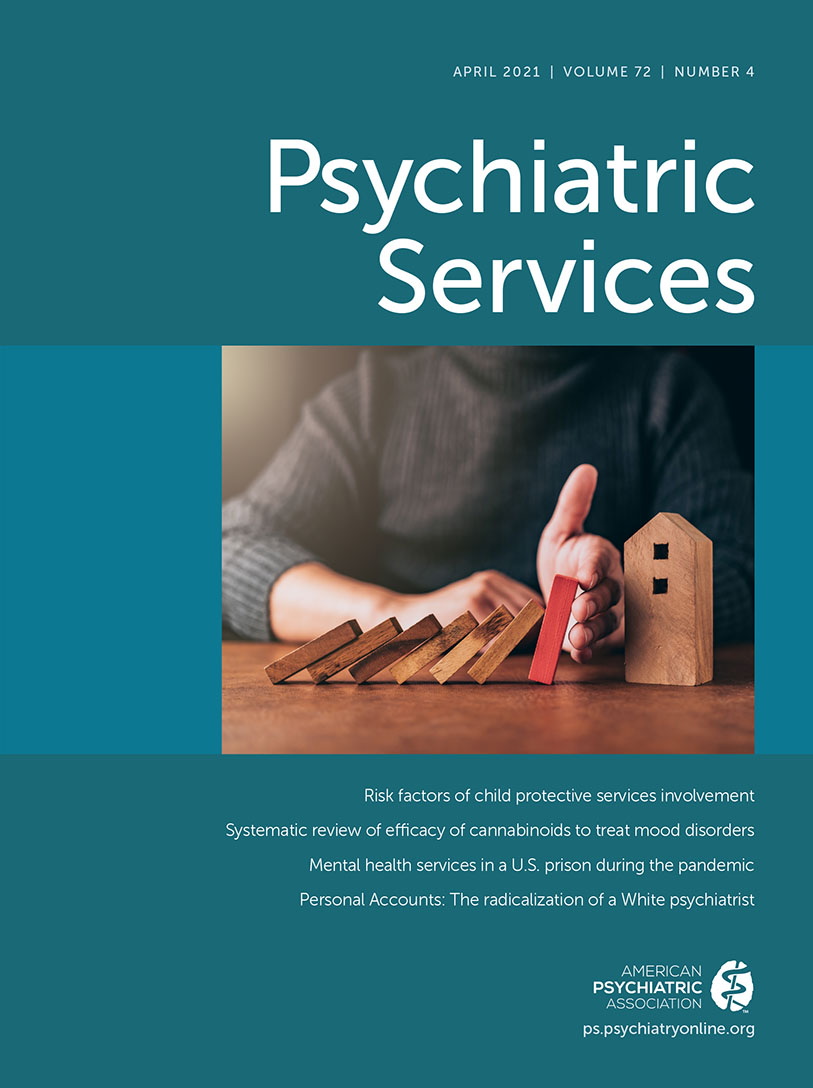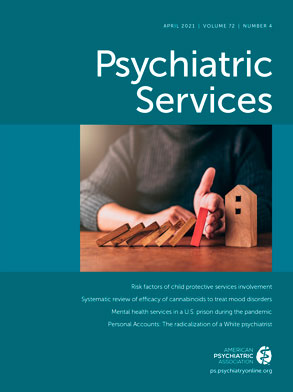A recent national study found that parenting rates among individuals with a diagnosis of a serious mental illness are similar to those in the general population (69% and 71%, respectively) (
1). Yet individuals with a serious mental illness are eight times more likely to have contact with child protective services (CPS) and 26 times more likely to have their children removed from their home than those without a psychiatric diagnosis. Mental health issues are typically viewed as a primary risk factor for child maltreatment (
2,
3), supporting a common perception that equates the presence of a psychiatric diagnosis with inadequate parenting. But to what extent is this an illusory belief that is drawing attention—and resources—away from other causes?
Poverty and unemployment (
4–
6), lack of affordable housing, lack of access to health care, community violence, social isolation, lack of social support, substance abuse, and criminal involvement (
4,
7–
10), along with low levels of general health and challenges due to managing a chronic illness (
11–
13), are all clearly associated with CPS involvement. Parents with psychiatric diagnoses are known to be disproportionally affected by these factors (
12,
14–
16). Findings from previous studies suggest that after controlling for some of these factors, the role of mental illness in predicting CPS involvement is significantly diminished (
15,
17,
18). This study extends this line of work to explore how such factors, along with mental health and substance use factors, relate to CPS involvement, which can result in a wide range of outcomes, including custody loss. The goal of this study was to further aid the development of effective supports for parents with serious mental illness.
Discussion
This study identified common risk factors of CPS involvement among parents with a serious mental illness. The parents with CPS contact were on average less educated, a finding consistent with those of other studies reporting significant associations between both maternal (
28) and paternal (
29) educational attainment and risk for CPS contact among parents in the general population. Race and ethnicity were associated with CPS contact; all of the Black, Latino/Hispanic, and Asian parents were in the CPS group. These disparities are seen in national data as well, where a disproportionate percentage of children in foster care are Black (23%) (
30).
An arrest record was also associated with CPS contact. In addition to charges that may warrant a CPS involvement, single parents with limited family networks or supports may lose custody of their children if no one is able to care for them. Once parents are incarcerated, it can be difficult for them to remain in contact with their children, and under the Adoption and Safe Families Act, the timeline to reunify is not adjusted to account for incarceration and reentry services, which often lack a family focus needed for successful reunification (
31). In addition, a history of criminal justice involvement can affect the ability to find work and housing, because questions about an arrest history are allowable on applications, and difficulties finding work and housing also affect parenting outcomes.
Previous research has found that exposure to stressful life events can affect parenting (
11,
15). This study did not find differences between the two groups on the ACEs measure, but both groups averaged a score higher than 4, which is noteworthy in light of the fact that only 12.5% of the U.S. population have a score greater than 4 (
32). The relatively frequent experience of adverse events among all parents with a serious mental illness may have limited our ability to detect differences in the total number of adverse experiences between the two groups. Nonetheless, the parents with CPS contact were more likely to report certain events, including having been assaulted with a weapon, having been sexually assaulted, or having had an unwanted or uncomfortable sexual experience. Exposure to these events is associated with experiencing violence later in life and may point to overlapping risk factors for violence, as well as generally poorer health and social outcomes (
33,
34).
Although the two groups did not differ on overall social support, the individuals in the CPS group reported less love and acceptance. These statistically significant differences in relationship-related factors may indicate that parents with CPS contact experience particularly challenging attachment-relationship issues that may also affect parenting quality and may lead to CPS involvement. Such findings point to the need for interventions that target attachment issues and enhance the ability of parents to develop positive relationships with their children. Social media and Internet-based platforms, as well as peer support interventions, may eliminate or reduce feelings of loneliness and elevate a sense of social support and care (
35). Overall, it is critical to seek out and connect parents with mental illnesses to parenting resources, including those that support these parents in developing basic household and childrearing skills (
36).
As is the case in the general population (
37), substance use was also a factor in CPS involvement in our sample of parents with serious mental illness. The individuals in the CPS group reported more potentially problematic substance use habits, and they particularly were more likely to report that others view their substance use as a problem. Differences in psychiatric service use were apparent; 25% of the CPS group did not have a psychiatric diagnosis at the time of their CPS contact, and plausibly as a result, they were also less likely to take prescribed medications at the time of CPS contact. The lack of a diagnosis among the individuals in the CPS group could reflect several factors, including not being identified as having a need for psychiatric services, not being interested in seeking such services, fear of losing custody of their children if viewed as nonadherent to treatment (
38), or not having access to psychiatric services. Not being engaged with the mental health system could increase CPS involvement as a result of untreated symptoms that may affect parenting.
Finally, the CPS group reported several needs related to parenting and child welfare, such as needing help with child development, child safety, and foster care, as well as social determinants such as needing help with transportation and housing. Even for parents engaged in the behavioral health treatment system, support for social needs is often not addressed in service provision for several reasons, including siloed funding streams, lack of available options for transportation and housing, and limited availability of programs that address social needs.
This study had some limitations. All reported results are essentially correlational, and no firm conclusions about causality should be inferred. Surveys are known to result in underrepresentation by race and gender, and this study also excluded those who did not speak English. The groups in this study came from a national survey, which also have such underrepresentation. The groups reported on experiences that may have occurred at different times (that is, current vs. past experiences), which may lead to differences in accuracy about the reported situation. The most significant limitation was that CPS-involved parents were reporting about events that occurred at a very stressful moment in their life, which may lead to a more negative bias in reporting on the situation, including a tendency to report more problems. Some measures for which differences were found, such as the ACEs, Life Events Checklist, and demographic characteristics, are likely less susceptible to this bias. Use of prospective studies would be one way to address this issue in future research. The parents in the two groups may also differ in other unknown ways from parents with mental illnesses who may have been unwilling to discuss these sensitive topics as part of a research study. The sample size in this study was also relatively small and may have led to some analyses being underpowered and a possible lack of generalizability of the results.
Conclusions
This study has important implications for future research, interventions, and policies. Similar to findings in other studies pertaining to custody loss (
15,
17,
18), ours suggest that risk factors for CPS involvement that affect the general population, such as racism, trauma, substance use, and lack of availability of supports, and that are more prevalent among those with serious mental illnesses, may partially explain the higher rates of CPS involvement we found for parents with serious mental illnesses. Recent legislative mandates, such as Families First and the Integrated Care for Kids grant from the Centers for Medicare and Medicaid Services, are focused on changes to funding streams and alternative payment models that allow for addressing these risk factors. These funding opportunities are designed to target these factors in a way that has not been addressed adequately to date. Interventions that target social disadvantages and stressors that disproportionately affect parents with serious mental illnesses—and particularly people of color—could decrease CPS involvement and allow these parents to experience the meaningful benefits of parenting. Such efforts will also likely benefit their children. Efforts to promote positive parenting can improve family stability and child well-being over the long term, because children who live with biological parents have fewer life problems later on, including less substance use (
39), teen pregnancy, and unemployment (
40).
It is also essential to acknowledge that most parents who have a diagnosis of a serious mental illness are not involved with the child welfare system—64% in one study (
1)—although they do experience more social disadvantages than parents without psychiatric diagnoses (
11,
41). Future studies should further explore resilience factors among these parents. Perceptions by the behavioral health and child welfare systems of parents with serious mental illnesses as “inadequate or unfit parents” may add to their burden. Often, individuals with mental illnesses are discouraged from taking on normative life roles, such as being a parent or employee, because of concern that doing so would be too stressful for them or beyond their abilities. The treatment and social service systems often miss opportunities to work with parents to view the parenting role as a source of meaning and strength, which may contribute to positive recovery-oriented outcomes (
42).
There is a growing recognition of the discrimination that parents with disabilities face when involved with the child welfare system or family courts and of the need for appropriate legal representation (
43). The federal government issuance of guidance to all courts and child welfare authorities on their need to comply with the Americans with Disabilities Act (ADA) when working with a parent with a disability recognizes that parenting is a civil right and that parents with disabilities are entitled to accommodations under the ADA (
44). The results of this study can be used to inform strategies to create policy changes for more effective support of these families.

